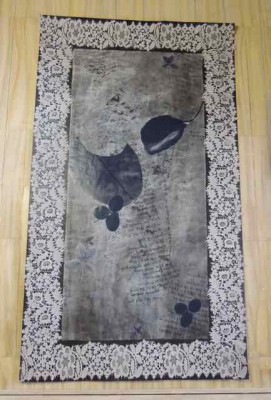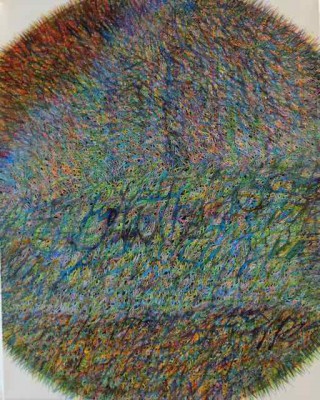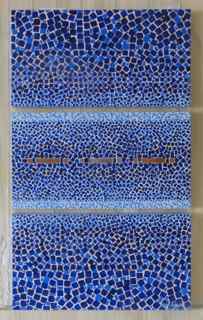Dieser Text wurde von Annelise Zwez im Rahmen untenstehenden Biennale-Events geschrieben. Obwohl mit positiven und kritischen Akzenten durchsetzt, ist es keine Kunst-Kritik im landläufigen Sinn; kein journalistischer Text, der sich an ein breites Publikum wendet, das noch nie von den Nine Dragon Heads gehört hat. Zielpublikum sind eher die Nine Dragon Heads selbst sowie ihr grosser Freundeskreis. Er ist englisch verfasst, da ein globales Publikum am ehesten über ein einfaches Englisch erreicht werden kann.
20 Years Nine Dragon Heads
Collateral Event of the 56th Venice Biennale
Jump into the Unknown
Exhibition, Performances, Documentations
Palazzo Loredan dell’Ambasciatore, Dorsoduro 1261/62, Venice
10th May to 17th June 2015
Facts, personal thoughts and a promenade alongside the works and events in and outside the Palazzo Loredan by Annelise Zwez. Editing: Suzanne Bartos.
Preamble
Over 20 years of Nine Dragon Head activities more than a hundred artists from all over the world have gathered for Art making, Symposia and Nomadic Parties. The participants of the 20 Year Event in Venice are not necessarily as the most important Dragon Heads of the last 20 years but are rather an open group of artists coming from Park Byoung Uk’s worldwide Dragon-Network. Personal and financial considerations decided on the participation, rather than artistic criteria on the part of the artistic director.
Remarks and Observations
- Different. Jump to the Unknown was different from all events of the Nine Dragon Heads so far. It was not a laboratory of spontaneous installations and performances, not an experimental field of artistic expression as characteristic of the Symposia and Nomadic Parties since 1995. Jump into the Unknown gathered works and performances resulting from several on location workshops – especially on the islands of Murano, Lido and Pellestrina, but also in Venice itself – since February 2014. The works shown at the Palazzo were therefore more elaborated, more definitive than works shown in improvised exhibitions alongside the Nine Dragon Heads activities (such as the ones in Gwangju (Korea) or the Artisterium in Tibilisi (Georgia)).
- Venice.The Nine Dragon Head spirit of being a critical platform for the awareness of environmental, social and historical issues in different cultures and countries of the world was nevertheless present in this show. On the one hand due to the fact that no other event at the 56th Venice Biennale focused so much on Venice itself as a historical site with lots of problems in its environmental, economic and social structures. On the other hand in the chosen topic for this show – Jump into the Unknown – that has as well a link to Nine Dragon Heads general concept as to the actual political situation in many regions of the world.
-
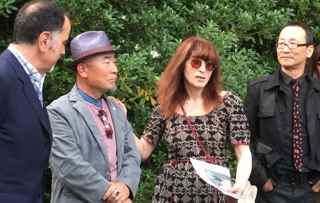 The curators: Park Byoung Uk, Magda Guruli, Kim, Jae Kwan, Vittorio.
The curators: Park Byoung Uk, Magda Guruli, Kim, Jae Kwan, Vittorio. - Un-curated. In the concept of Jump into the Unknown is pointed out that the selection process is being “un-curated”. This is not to be understood in the sense that the projects of the artists were not vetted. All artists had to submit their intensions and more than one had to rethink and restructure his or her idea after the first presentation. Un-curated means that Park Byoung Uk and his board (Magda Guruli, Ali Bramwell, Gabriel Adams) did not invite artists to fulfil the organisation’s concept. The board counted on the artistic experience and self-responsibility of the participants according to their own lights.
The Nine Dragon Head Artists
Jump into the Unknown was comprised of 32 artistic positions by 40 artists representing 16 countries from all continents. Some of the artists were “old” Nine Dragon Heads like Ali Bramwell, Bedri Baykam, Alois Schild, Susanne Muller and Iliko Zautashvili. Some only recently joined the “family” of the Dragon Heads like Anna-Lea Kopperi, Aleksandra Janik/Magdalena Hlawacz and Enrique Muñoz Garcìa.
One might say that the time is over, when it was necessary to count the number of men and women artists in a show. But it is nevertheless nice to point out that in Jump into the Unknown the gender balance was about 50/50. And that the exhibition was – due to the long duration of Nine Dragon Heads activities – not a platform for youngsters, but an event of all generations active in the present. From Phil Dadson (NZ 1946) and Gordana Andejelic Galic (BA 1949) to Alois Schild (AT 1960) and Jessy Rahman (NL 1961) to Yoo La Shin (KR 1972) and Gabriel Edward Adams (US 1978).
Special Guests from Korea
Due to the extraordinary event of Nine Dragon Heads being present at the 56th Venice Biennale, Park Byoung Uk decided along with the Korean Culture department to give 9 artists from South-Korea – the home base of the Nine Dragon Heads – the chance to join the Jump to the Unknown. The selection of the special guests was made by the Korean curator Kim, Jae Kwan. Two women artists out of his selection were related to 9DH already in the past (Yoo, Joung Hye; Sim, Yea Bun). The others joined the group for the first time. Their different style and way of working was visible in the exhibition.
The artistic projects
As mentioned above Jump into the Unknown was an un-curated show and therefore the projects were not necessarily interpretations of the title and some only broadly linked to Venice and the three islands chosen for the preceding workshops. The participants were free in their decisions as to what they wanted to present. Nevertheless it is enriching to analyse the projects along the lines of the chosen topics. Of the 32 works more than a third refer directly to Venice or the islands, either in a mixture of a documentary and poetics, or in a more political, philosophical or atmospheric way.
As to the islands, it is interesting to see that Murano and Pellestrina inspired several artists for their projects, but the Lido none. “The Lido is to similar to Venice itself”, supposed one of the artists, “whereas Murano with its glass-work-background and Pellestrina with its problems of depopulation were attractive in the development of artistic works”.
Some of the especially for Venice realized projects could easily be associated with the theme of the Jump into the Unknown – be it political, artistic, spiritual or romantic. Others kept in mind that a lot of the local themes are also relevant in many other countries of the world as well, especially in the social and political context.
This wide range made the exhibition rich, interesting and continuously loaded with new ideas. The fact that not all of the works of the Korean guests joined the spirit of the Nine Dragon Head thinking and working can be regretted or – as there are always two sides of a coin – considered as some sort of calming and concentration on the traditional value of a “work” made in still dialogue by the artist with himself, with nature, the universe and his personal vision of it. Looking back to the event as a whole I tend towards this second approach.
Of course an artistic project is seldom one-sided and so many works answer to several aspects.
The 20th anniversary of the Nine Dragon Heads
The event in Venice was – especially in the beginning of the planning – conceived as 20th anniversary of Nine Dragon Heads. During the process of defining the concept this aspect was reduced to text- and video-plates in the steel tent-sculpture of Alois Schild. Only a few projects referred in addition to the documentation directly to earlier Symposia or Nomadic Parties (for instance the video of Gordana Andjelic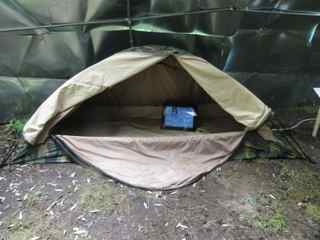 from 2005, showing a footprint “drawing” in the no man’s land between North and South Korea or the assemblage of Yusuf Hadzifejzovic mirroring the misery and the absurdity of war and referring to 9dh’s link to the Sarajevo Winter Festivals since the war in Bosnia).
from 2005, showing a footprint “drawing” in the no man’s land between North and South Korea or the assemblage of Yusuf Hadzifejzovic mirroring the misery and the absurdity of war and referring to 9dh’s link to the Sarajevo Winter Festivals since the war in Bosnia).
Although such a retrospective would have been laborious (and expensive) I personally regret the reduction and think that it would have been enriching if the whole shelter had shown historical aspects with a real intensity. It would have shown the profile of the Nine Dragon Head idea and activities over the whole period in a more sensual, direct and emotional way. And it would have made more evident that the dominating shell of Alois Schild in the garden of the Palazzo was not intended to be a tent in the ordinary sense but a temporary sculpture, intentionally made with simple technique in order to visualise the “nomadic” formula of the Nine Dragon Heads.
Jump into the Unknown – Bedri Baykam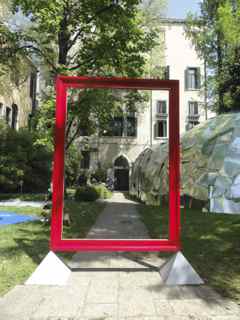
It was a lucky coincidence that since 2013 Bedri Baykam works with the simple metaphor of a mens size open frame as the brand for his art. Installed directly behind the entrance to the garden of the Palazzo the visitors were invited to jump into the exhibition. In reality most people preferred the loop way around the huge frame, but mentally the symbol was present nevertheless. And before leaving the palazzo through or around Bedri Baykams work many visitors took their camera for a framed picture of their companions. Within the art work of the artist the meaning of the frame is of course more complex. Baykam (*1957), who is an important intellectual personality in Turkey, was since his early childhood a figurative, narrative painter and mixed media artist. But at the age of 55 following a decisive incident in his life he could not go on, freed himself of all “ready mades” (in the sense of Duchamp) in order to open up a view into space which activates the spectator to beome aware of what they see and what it means to them. Frames as signals for vivid consciousness. The frame for Jump into the Unknown was the first to have two different sides, a red one and a baroque one. The red one in the manner of pop art as welcome to the exhibition of contemporary art, the golden sculptured side a gateway back to Venice.
What waits behind the veil? – Erika Batdorf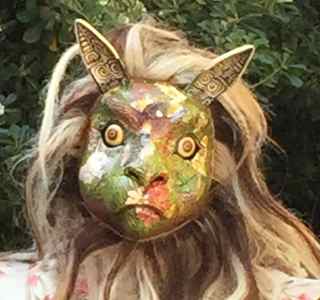
A Jump into the Unknown of an entirely different character was the theatre of mystery called “Burnish” by Erika Batdorf (in collaboration with Mark David Hosale and Suzanne Bartos) – an ongoing performance during the opening days of the Biennale. The Unknown was behind the veiled window of a brownish felt-tent where the individually received clients could see an enchanting creature with a women’s costume and an impressive dog-like, multi-coloured fantasy masque. They were invited to burn a bad characteristic such as fear, arrogance, meanness etc. in a fictitious spiritual session. A colour plus a beloved dead person conjured to help while listening to the enigmatic rhythm of the creature’s voice. It was not necessary to understand every word, but what I personally took away with me, will accompany me into the future: “Fear is just a fiction”, I heard the voice say and the words jumped into my brain. Light signals showing the richly decorated inside of the tent and marvellous songs filled fascinating minutes. With a little souvenir finally the therapy-guests were sent back into reality. Erika Batorf and her team did a great work – in its character far away from all other projects. It can hardly be called a performance, rather a salon piece in a circus for mysterious events. Is it the hidden consciousness of the rituals in Indian and Far Eastern religions which made it possible to integrate projects like this one of the Canadian Erika Batdorf into the basket of possibilities that is the Nine Dragon Heads universe?
Rapture of privacy? – Harold de Bree/Mike Watsons
There was no philosophical intention to place the survey-video-camera-sculpture of Harold de Bree and Mike Watson immediately behind of Batorf’s tent. But it was disconcerting to think of the two “big brothers watching you” together. Is there maybe a connection we never thought of before? – The spiritual, invisible links of men with the universe on the one hand and the covert cameras making visible every movement, every breath in our real world? Do both dimensions finally show us that we are not as free as we thought? Let’s leave that field, it gets risky.
Harald de Brees and Mike Watsons camera-candelabra was a clever mixture of constructivist sculpture – every camera being boxed in a clear geometrical form – and a narrative object suggesting a world that monitors every corner of our lives. Pretending to give us security, it ignores the rapture of privacy. It is frightening that already we are so used to video-cameras that I am not sure whether all visitors to the exhibition in the palazzo realised the art-status of the work, as it was – of course – installed as if it stood there all the time.
Palazzo Loredan with the flag of the exhibition (left), the banner of the project de Bree/Watson (in the middle) and some of the „black“ guys, just before leaving for the city.
The sculpture was however not the main gig of their project. Not seen by the visitors to the Palazzo but seen by the wider public around the city, a team of The Hague based artist Harold de Bree and the Rome based English Philosopher Mike Watson staged short performances with a troupe of surveillance guys in black uniforms. During the Preview-Days of the Biennale the group of six men showed up in a variety of busy areas throughout Venice, suggesting to the public that they were conducting a police security check. As they quickly dissolved the sudden tension by performing short dance choreographies on the spot, they provoked smiling and laughter – a laughter however which stuck in the throat when one considered the complexity of the artistic gymnastics and the concept behind it: To make us aware of the signs of an upcoming police state, which restricts individual freedom.
The concept went even further as the project was accompanied by a brochure that listed up the conditions of imprisonment in a great number of countries all over the world. This was visualised in the form that can be found on the internet – on sites such as Human Rights Watch and similar NGO’s.
The substantially conceived project showed in a clear way that the Nine Dragon Head artists show up as a community for Symposia and Nomadic Parties, but that all artists follow an independent artistic career apart from 9dh. The Jump to the Unknown with its special parameters gave those who wanted it a platform to present themselves in a wider context than the usual one of the Nine Dragon Heads. The result of the collaboration of Harold de Bree with Mike Watson was such an example, interesting and visionary but also a bit foreign within the manifestation of 9dh as a whole.
What about the lizard? – Iliko Zautashvili
Another work in the exhibition with a distinct political impact was the “Public Opinion”-piece of Tibilisi based artist Iliko Zautashvili, an old companion of the Nine Dragon Heads and an important artist in Georgia going back to the 1970ties. It is necessary to mention his background because the great changes in the status of this former Soviet Republic makes a political thinking within art, almost compulsory. The method of Zautashvili’s method derives from a wide-awake consciousness, not only on behalf of strictly political matters but of civilisation as a whole. He considers ethical, environmental, gender and other aspects as well. His “Public Opinion”-piece is a long white silky banner with pictures, slogans and headlines from newspapers and magazines back to the Second World War, most of them in English. The range goes from “French attack Nazi line” alongside “Man walk’s on moon” and “This time it was a flag, next time it could be a BOMB” to “U.S. attacked” or “Putin’s war”. The challenge to put the slogans in a chronological order is part of the game, but behind the infotainment is the picture – and also the weight – of what constitutes the collective memory of us all: Nothing but superficial fragments of what is far more complex. And yet it is what lays the ground of the public opinion, including the menacing potential to manipulate it. The possibility of “branding” names and events is pointed out by the installation of the banner being draped over an ironing board and with a real iron on it. An iron however that is a stamp with the letters PUBLIC OPINION. A ventilator turns the banner into a river of waves suggesting this deception going on in time. It is typical and enriching for the spectators that the artist often slips a humorous element into his works, in that way giving them a subversive touch of absurdity click for more info. Here it is a little lizard lying on the board, made of steel but with its brilliance suggesting it is one with thousands of tiny little diamonds. That this can be taken as an additional metaphor for the whole work is obvious.
Straight, left, right, right, left – Ali Bramwell
We see, wandering from one work to the other, that political issues cannot be confined to national borders. Nevertheless it was interesting to look whether there weren’t any political works in the show with a local focus and global implications. Yes, there was one – the “Hollow Conductor”-piece of Ali Bramwell, another old companion of the Ni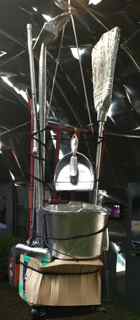 ne Dragon Heads. This New Zealand based artist often works with electric frequencies. Basically invisible, they can be made audible by amplifiers and, with a special tool, can be connected and combined with the spectators energetic body-signals, in order to create an individual dialogue between spectator and work. This is interesting and emotional because what it meant in Bramwell’s Venice piece, was that the visitors could not avoid getting directly involved in the sound of the piece. It was called “Hollow Conductors”, which hinted that there was something wrong about it, that there might be a misrouting. Questions arised.
ne Dragon Heads. This New Zealand based artist often works with electric frequencies. Basically invisible, they can be made audible by amplifiers and, with a special tool, can be connected and combined with the spectators energetic body-signals, in order to create an individual dialogue between spectator and work. This is interesting and emotional because what it meant in Bramwell’s Venice piece, was that the visitors could not avoid getting directly involved in the sound of the piece. It was called “Hollow Conductors”, which hinted that there was something wrong about it, that there might be a misrouting. Questions arised.
The object with the conductors tool in its basket could easily be identified, as there are thousands of pushcarts with cleaning utensils around Venice, often handled by men that are recognisably migrants, from North Africa for instance. The brooms and tools were carefully covered with sheets of aluminium foil. On the one hand because aluminium conducts electricity, but in addition to this functional aspect the silver gloss made it also a symbolic object. Reminding us of the social moments of migration, of the men (seldom women!) coming over the Mediterranean Sea and landing at the bottom of the social hierarchy as cleaning “boys” in the narrow streets of an always dirty city. And those who have these jobs are even the lucky ones!
From the artistic point of view it is important to include the conceptually concise video by Enrique Muñoz Garcìa. It shows the artist in the early morning hours walking with the pushcart through the still quiet quarter of Venice’s fish- and vegetable market near the Rialto bridge. We see her from the back, from the side, but never her face – there is no personal dialogue with her, just the equal walking of a person – no stops, no action, no cleaning – just the measured walking, right, left, straight, left, left, right. This gives us as spectators the calm and the time to reflect, which is surely the intention. I love the piece, but within the exhibition I found it a pity that the video was not integrated into the work – only being seen on the documentation screen. From the point of view of visibility in Schild’s garden-shelter this was not absolutely tops.
Migrants are humans! – Denizhan Özer
Migration as existential Jump to the Unknown was also the topic of the project of London and Istanbul based artist Denizhan Özer. He joined the Nine Dragon Heads quite some years ago via his friend Bedry Baykam. For years already Özer has dealt with the issue of immigration, especially to England, where the problem, as a conclusion of Great Britain’s colonial history, is actual since decades already. It is not so much the global, political aspect that interests him, but the stories, the people behind the facts and figures. Where do they come from, why did they “jump into the unknown”, were they accepted or sent back and so on. In late 2014 there was an important one-man-show by Denizhan Özer on the topic at “Piramid Sanat” in Istanbul. The Venice piece called “Static Lives” (which was previously already shown in Istanbul) was some sort of wall paper, consisting of 42 aluminium plates, that showed photocopies of immigration questionnaires. So as not to get in trouble with the authorities, the names and numbers were changed for the exhibition piece. Unfortunately the second part of the project – a linen with a great number of passport photographs of people who had applied for asylum printed on it – could (for reasons of space) not be shown in the exhibition. This would have given a much stronger emotional impact to the project as a whole. To exhibit it in Alois Schild’s shelter, which intentionally signalled temporality, was from the issue of the work certainly a good idea, but in reality the work was lost between the 20-year-9dh documentation-plates to the right and the video-projections to the left. It could not express its potency sufficiently.
Let’s jump
Let’s jump – not into the unknown – but into the works dealing directly with the city of Venice and the surrounding islands. Mention needs to be made of a sound piece of Charlotte Parallel, the water-stories by Susanne Muller, a slow canoe tour by Phil Dadson, the wooden boat of Gabriel Adams, Diek Grobler’s stick parade, the performance by Gordana Andjelic, the horse stories of the Quartair group, an environmental piece by Yoko Kajio & Jason Hawkes, “The Net” by Yoo La Shin, the “Isle of dreams” by Anna-Lea Kopperi & Heini Nieminen and “La Tombola” by Enrique Muñoz Garcìa.
The projects of Parallel and Muller both register things that cannot be seen, felt or heard in every day life. Both point out that their methods are precise but pseudo scientific and in their vision artistic.
Audible City – Charlotte Parallel
The New Zealand based Charlotte Parallel, who has worked together with Ali Bramwell on other occasions, toured through Venice by day and by night to collect sound signals. Her itinerary took her, using specially constructed tools, into the public space, close to the canals and through the illuminated streets of night time. Subsequently the collected and amplified electronic sounds were combined to form an unusual, surprising – musical – sound scenery.
Four Venice map boxes with electronic devices on the inside and little black buttons on the surface invited the visitors of the exhibition to press one or several of them, to listen to a single or multiplied electronic melodies. The result did not have any didactic guidance, did not reveal the origin of the signals; it trusted entirely on the fascination of an unknown, audible city. Yet it is helpful to have a bit more background information; the fact that, for instance, every electrical activity is the result of a vibration that can be registered by a solar panel and can be transformed, using an amplifier, into sound. This opens up an unexpected and rich field into an unknown “visibility” of the world, a “parallel” world (!). This aspect refers of course above all to the night-tours alongside the canals under all sorts of electric lighting. In addition the project shares the common interest of Parallel and Bramwell in a contemporary artistic language, that integrates electronic sound as a new form of “brush” to “paint” pictures.
When stones swim, leaves sink – susanne muller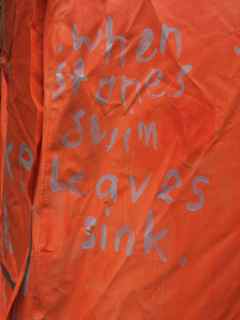
As it has often been the case in art history, new technical equipment brought new aspects into art – remember the coming up of the first mobile video cameras in 1965 and Nam June Paiks first experiments with them! Also the work of Susanne Muller would not be possible without the invention of tiny little cameras of good quality cased within special transparent boxes, which make it possible to use them under water. “When stones swim, leaves sink” is not the first project where Muller uses them, but it is a very special one. As with the work of Charlotte Parallel, Susanne Muller’s piece draws some sort of Venice Map. In 33 sites she threw the switched-on little camera into the water – holding on with a lead as if it would be her dog. The motivation was on the one hand an investigation, but even more the curiosity of what the camera sees and hears with its eye and its ear during it’s journey down- and upwards. This moment of independence of the tool is a very important and enriching aspect of the work because it gives the artist in following steps the possibility of intervening on the video – with facts and figures, but also with drawings or even surrealistic thoughts, in order to bring atmospheric moments into the installation.
The way of presenting the piece was an integral part of the project. Muller showed it in an orange coloured tent – as we possibly know it from archaeological excavations or other delicate underground works. This accentuated the idea of a labor – all the more as the artist showed the sequence of the 33 little films on a flat screen on the ground and made two other versions out of it, with drawings of Venice on the one hand and remarks on the sedimentation on the other hand. That the project was a Venice piece, but also a very personal one, resides in the fact that the artist’s father was a well known hydrologist in Switzerland.
Venice and its horses – Jessy Rahman, Pieterje van Splunter, Geeske Harting, Thom Vink
Is it possible to design a Venice project without water? Yes it is! The Quartair group with Jessy Rahman, Thom Vink, Pieterje van Splunter and Geeske Harting from the Netherlands for instance started their investigation with the incredible story of the horse sculptures on the Basilica of San Marco, that were, in course of time, looted, stolen, returned and finally copied because of pollution. From this starting point the four artists developed four stories of Venetian horses – each a separate sequence – presented as video-performances (all videos by Enrique Muñoz Garcìa). The physical center of the work however was a life-size horse, built of foam pieces in slightly different colours such as light blue, light green, beige, of wood and visible screws, suggestive of a construction set. The horse had a tail and a forelock of course and – very important – little wheels in order to be able to move through Venice. Everybody loved the piece. 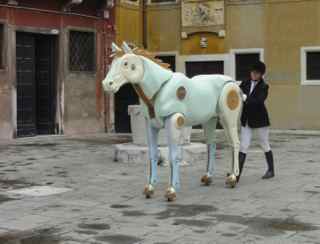 One morning it left its site and “went” – pushed by a lady in full equestrian costume (Pieterje van Splunter) – from the Palazzo through the narrow little streets, even over bridges to the “Fondamenta Zattere”. The exhaustive nature of this performance (that was photographed by hundreds of tourists!) was a humorous statement by van Splunter on the absurd and desperate efforts of artists to shape horses as insignia of power throughout history of art, be it in Venice or elsewhere. Enrique Muñoz Garcìa filmed the performance that became afterwards a chapter in the video of the Quartair’s Venice horse stories, shown on a monitor in the exhibition. A projection onto a wall would have been more impressive, but group shows have their own parameters….
One morning it left its site and “went” – pushed by a lady in full equestrian costume (Pieterje van Splunter) – from the Palazzo through the narrow little streets, even over bridges to the “Fondamenta Zattere”. The exhaustive nature of this performance (that was photographed by hundreds of tourists!) was a humorous statement by van Splunter on the absurd and desperate efforts of artists to shape horses as insignia of power throughout history of art, be it in Venice or elsewhere. Enrique Muñoz Garcìa filmed the performance that became afterwards a chapter in the video of the Quartair’s Venice horse stories, shown on a monitor in the exhibition. A projection onto a wall would have been more impressive, but group shows have their own parameters….
Geeske Harting chose an entirely other incident for her horse story. She was touched by the legend that – more than 50 years ago – the last horse of Venice was taunted more and more as motor power had definitely replaced its services. Harting decided to try to give it back its dignity. In a performance with several chapters the death of the horse was re-enacted on the Fondamenta Zattere. As restricted in her mobility, the artists effort of drawing the outline of the body of the dead horse on the pavement created a very emotional situation for all, who were there. It was as if the mourning would be visible.  After the corpse had been borne away, the funeral guests bestrew the horse’s outline with flowers as if it’s death had just taken place. History had come to presence. It was a touching performance in real time and it is a touching video-performance thanks to Enrique Muñoz Garcìa.
After the corpse had been borne away, the funeral guests bestrew the horse’s outline with flowers as if it’s death had just taken place. History had come to presence. It was a touching performance in real time and it is a touching video-performance thanks to Enrique Muñoz Garcìa.
Some Quartair chapters are to be taken with a pinch of salt…especially the fifth, that was spontaneously realised during the set-up days. It made it possible for the horse to have a ride in a gondola (something that is in every day Venice life far to expensive for ordinary artists…). With wood plates, additional screws and stones the safety for the horse and the  “gondoliere” was assured. Did I imagine it only or did I really see that the horse was proud that finally someone recognised the importance of his majesty’s visit to Venice? With a vodka douche on the arrival at the Palazzo the Nine Dragon Heads payed their tribute to him.
“gondoliere” was assured. Did I imagine it only or did I really see that the horse was proud that finally someone recognised the importance of his majesty’s visit to Venice? With a vodka douche on the arrival at the Palazzo the Nine Dragon Heads payed their tribute to him.
The wildest horse story was the one of Jessy Rahman, an “old” Nine Dragon Head and the initiator of the Venice Quartair project. In his artistic work The Hague based artist often tries to create a cultural dialogue between his original home-country, which is Surinam, and the place where he stays as a guest, focussing hereby often old, eventually folkloristic traditions. For Venice he reverted to the old colonial tradition of playful dances with self-made card board horses as a sign of invincibility. He made contact with the last teacher on Pellestrina (there are less and less children on the island) and suggested a workshop, which the lady accepted and so girls and boys of Pellestrina proved their strength, dancing with the card board horses round the fountain in the court yard of their school. Surely an event that they will remember, even if they probably didn’t realise that it was an artistic project that they were part of…
Berlusconi cinque – Enrique Muñoz Garcìa
The Quartair project was surely the most narrative of the show, but there was another piece, telling a story: “La Tombola” by the Switzerland based Chilean artist Enrique Muñoz Garcìa. During a stay on Pellestrina, the photographer got in contact with the local population of the island. Those who have been on a Nomadic Party with Munoz know, that it is one of this artist’s special talents is to be able to communicate with strangers that he meets here and there, and to convince them to allow a photograph or even realise a project with him. Often they are people in very special social situations. This is the case on Pellestrina with its over aged population. However the documentary film he made over several sessions is not at all depressing. Elderly people – among them an old rowing champion – tell about former times, not bitter, not even melancholic, just realistic and never without humour. Life is a play, they seem to say – in the true sense of the word as in the middle of the film there are Pellestrinian women who meet several times a week for “La Tombola” – a play with rows of numbers drawn on self-made cardboards. The captain calls them out, loud and clear: “Venticinque, Diciannove…” and sometimes (like a secret code) combinations such as “Berlusconi cinque”. 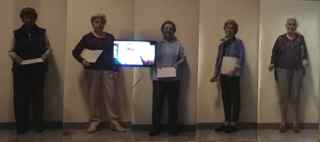 The women put “stones” in different materials on the corresponding numbers on their board. Laughing and the singing of popular melodies go along with the play, creating the so cheerful and yet touching atmosphere that characterises Enrique Muñoz Garcìa’s documentary. The artist showed the film together with life-size photographic portraits of the women who played “La Tombola”. They became a double presence being both players and individual personalities, a mirror of Pellestrina in 2015. The project was shown in a side room; nevertheless the voice calling out the numbers was quite dominant in the entire indoor-exhibition, perhaps even too dominant for certain rather silent works.
The women put “stones” in different materials on the corresponding numbers on their board. Laughing and the singing of popular melodies go along with the play, creating the so cheerful and yet touching atmosphere that characterises Enrique Muñoz Garcìa’s documentary. The artist showed the film together with life-size photographic portraits of the women who played “La Tombola”. They became a double presence being both players and individual personalities, a mirror of Pellestrina in 2015. The project was shown in a side room; nevertheless the voice calling out the numbers was quite dominant in the entire indoor-exhibition, perhaps even too dominant for certain rather silent works.
Is there a reason why the two Pellestrina-pieces (Rahman/Muñoz Garcìa) in the show are made by men and the two Murano-works by women (Anna-Lea Kopperi&Heini Nieminen/Yoo La Shin)? Difficult to say, but maybe the romantic touch of the no man’s land in the the outskirts of Murano with the thousands of coloured glass fragments was especially inspiring to women. At least one could find this touch as well in the workshop of Kopperi&Nieminen, which dealt with dreams, as well as in Yoo La Shin’s mystic feminine creature rising out of the muddy ground of the Island.
Melancholia in every step – Yoo, La Shin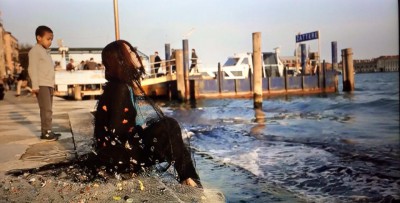
Seoul based Korean artist Yoo, La Shin has shown with Nine Dragon Heads several times before. Her work often evokes a critical view of human behaviour and women’s position in it. The object she showed in Venice was extremely beautiful, in some way a dream-dress. At the base it was a long and wide fisherman’s net as used in fishing villages in Korea as well as in Europe. The nylon thread gave it a transparent shine. It was decorated with hundreds of rings and broaches with coloured Murano glass fragments as “stones”. Yoo La Shin had collected the broken fragments during a workshop, transported them back to Korea, transformed them into jewellery with the help of a woman friend and brought them back to their origin. The center of her presentation was however a performance (filmed by Tae Kyu Jeong), showing her with the net as costume, first in the liminal zone between sea and land on Murano and then – while the city slept – wandering through Venice, through San Marco’s square, over the Academia-Bridge, alongside illuminated souvenir shops and sitting by the banks of the Fondamenta Zattere. Her silent walking with the net dress trailing behind her was like a nightly living stream. Melancholia inhabited every step she took as if she was mourning about something that no longer existed, except as a phantom in the night. And talking to her, she confirms her artistic intention was to express her regret that the extreme tourism, with its capitalistic structure, will destroy the old spirit of Venice.
I am not sure wether this “spirit”, charmed by so many painters and poets, was in fact Venice’s reality throughout the centuries. It’s history tells us as much about ruthless struggle for power and wealth as anywhere else. But Venice’s extraordinary construction with thousands of wooden pylons supporting it, its importance as a trading town at the beginning and the end of the Silk Road from Europe to the Far East, it’s unique canal-system and the beautiful Palazzi showing the wealth of the noble families, has made it a “must” for all travellers since the late 18th century.
Of course this Venice also inspired some of the Nine Dragon Head artists; in different ways. Gordana Andjelic for instance showed in her performance during the opening-event the skew, fragile position of the city and the desperate struggle to hold it upright. A film showing chain saws, that felled one tree after another, while the artist drew (at first invisible to the spectators) a sketch of the outlines of the city slowly tilting into the sea, visualised Andjelic’s intention. I’m sure, she did not only mean the geological, but also the cultural situation, in which the aim to increase the number of tourists dominates, there by killing just this charmed spirit of Venice.
Reality and its reflex – Phil Dadson
Phil Dadsons approach to the “spirit of Venice” was far more seductive and on the whole a marvellous “picture”. Already the fact that he was successfully able to “paint” it, was a balsam for the soul… Venice in silence! The New Zealand based artist is known as a video artist, but is also a musician who uses natural artefacts as “instruments”. In the early morning hours and towards evening Dadson, his camera and an assistant canoed through the canals of the city. He was lucky, the sun shone on the days he was shooting, so that the water was mirror like and reality and its reflection were almost equivalent. Clearly he’d played with it in the final video and intentionnally touched symbolic levels choosing sequences of upright views and others that were upside down. But emotionally essential to appreciate the video was the elimination of the pulsing life of the city – not a single motor boat crosses the route, rarely does one see a person on a bridge. It seems to be absolutely silent so that when this silence is abruptly cut off as, for instance, a loud voice starts singing the short part of an aria, it is as if it comes from another world. And yet, suddenly a little child is crying – life enters, Venice as the city it is today. Then it sinks back into silence, until it is cut off again and for a short time the echo of the artist’s voice under a bridge fills the exhibition hall.
 The video was presented as double screening, what gave at first view the idea of a binocular view of the canal. This turned however soon out to be an illusion. Instead came up a visual melody of delicate changes. It was a good idea of the artist to show “Anatomia Sonora de Camera” as a installation with a viewing chair and double paddle, so that the ensemble became some sort of a cabinet.
The video was presented as double screening, what gave at first view the idea of a binocular view of the canal. This turned however soon out to be an illusion. Instead came up a visual melody of delicate changes. It was a good idea of the artist to show “Anatomia Sonora de Camera” as a installation with a viewing chair and double paddle, so that the ensemble became some sort of a cabinet.
The dance of the tripods – Diek Grobler
Not only are the bridges icons of Venice; perhaps on a more profane level the wooden tripods, demarcating the boat “streets” around the city, are also icons. Whereas the wooden construction to stabilize the city from beneath cannot be seen, the trunks from which the tripods are made, are a dominant and visible sign when arriving in Venice or leaving the lagoon. With the going up and down of the boats they seem to move in sympathy. And this is exactly what fascinated 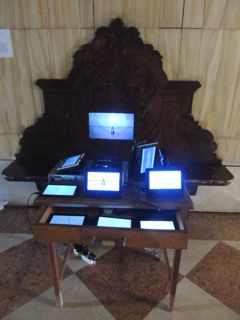 the South African Nine Dragon Head Diek Grobler, being known internationally as a specialist in animated films. He filmed hundreds of tripods (with and without a sea gulls on the top) from different boats and in different areas around the city. With this basic material he then developed a choreography and animated the film to create “The dance of the tripods”. Shown on nine tablet screens on and in a wooden table and on a beamer-projection at the back of a bank belonging to the Palazzo, the film-installation “So much depends upon a stick in the mud” showed a lively rhythm of the traffic outside the town wall. Out of respect to the many art works shown in the Palazzo Hall, Grobler abstained from integrating the sound of wind and weather and boats and gulls…..but next time in Johannesburg, who knows.
the South African Nine Dragon Head Diek Grobler, being known internationally as a specialist in animated films. He filmed hundreds of tripods (with and without a sea gulls on the top) from different boats and in different areas around the city. With this basic material he then developed a choreography and animated the film to create “The dance of the tripods”. Shown on nine tablet screens on and in a wooden table and on a beamer-projection at the back of a bank belonging to the Palazzo, the film-installation “So much depends upon a stick in the mud” showed a lively rhythm of the traffic outside the town wall. Out of respect to the many art works shown in the Palazzo Hall, Grobler abstained from integrating the sound of wind and weather and boats and gulls…..but next time in Johannesburg, who knows.
A Talisman – Kazunori Kitazawa
One piece was probably not seen by many visitors of the exhibition as it was hidden under a tree, but it was important for the spirit of the event: 20 Years Nine Dragon Heads and – I presume – very important for Park Byoung Uk himself, as artistic director and founder of the Nine Dragon Head idea. I mean the little “Far East Sculpture” of the Tokyo based artist Kazunori Kitazawa. It is a small wooden box with feathers of different sizes stuck in little wholes in the lid and some feather down on the inside of the box. It is part of the Nine Dragon Head collection and has been shown in different 9dh-exhibitions already.  I would call it a talisman, “telling” that 9dh should never forget its spiritual dimension, its concentration on harmony of the world and the universe, its environmental focus, its attitude of humility in the face of corrupt business, which is far to common in todays world. With the participation at the Biennale of Venice there was a danger of forgetting 9dh’s ideals and there were, as a matter of fact, not many works directly focussing on the environmental threat to the planet, which is highlighted in every general text about Nine Dragon Heads.
I would call it a talisman, “telling” that 9dh should never forget its spiritual dimension, its concentration on harmony of the world and the universe, its environmental focus, its attitude of humility in the face of corrupt business, which is far to common in todays world. With the participation at the Biennale of Venice there was a danger of forgetting 9dh’s ideals and there were, as a matter of fact, not many works directly focussing on the environmental threat to the planet, which is highlighted in every general text about Nine Dragon Heads.
Going forward or backwards? – Yoki Kajio/Jason Hawkes
An interesting contribution to the topic of environment was the work that Yoko Kajio elaborated together with Jason Hawkes, both living and working in Adelaide in Australia. Whereas Yoko Kajios way of working is familiar to Nine Dragon Heads, the Venice piece was, for the first time, a collaboration. Without giving clear answers they asked very clearly: Is an attempt to live in a narrow connection with nature in 2015 a nostalgic reconstruction of past times? Wouldn’t it be better to accept a joint venture, which real and virtual world have agreed on over the past decades and develop a new strategy for survival out of it? Venice’s experience with the sea, it’s fight against it’s own destruction is, for Kajio and Hawkes, a good example.
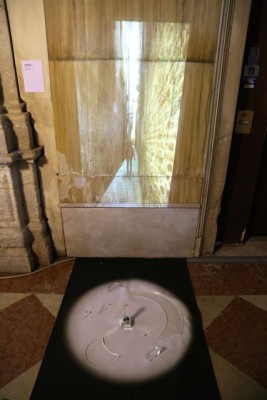 That the two artists see the development in a universal context, was shown in the work presented. Within a cone of light on the ground three-dimensional, transparent forms refer to celestial bodies, and the interaction between them and their influence on planet earth, and especially it’s seas make the connection with Venice evident. The transparency made clear that the installation was not to be understood as an astronomical model, but as an image of a universal structure, of which the planet earth is a little piece. Next to it and projected directly onto the wall, with all its little marks of use, there was a video of the artist walking trough the narrow streets of Venice (Camera: Jason Hawkes). Her rambling reminiscent of the fact that Yoko Kaijo’s artistic work has a strong focus on performance. As Ali Bramwell, as Phil Dadson, Kaijo/Hawkes all managed to film in the city without tourist crowds being visible. With the result, that walking and mapping the town came to be the same thing and in this way combined a real and an abstract quality. Thus the two parts of the installation were able to show thinking and living as being the two sides of the same coin.
That the two artists see the development in a universal context, was shown in the work presented. Within a cone of light on the ground three-dimensional, transparent forms refer to celestial bodies, and the interaction between them and their influence on planet earth, and especially it’s seas make the connection with Venice evident. The transparency made clear that the installation was not to be understood as an astronomical model, but as an image of a universal structure, of which the planet earth is a little piece. Next to it and projected directly onto the wall, with all its little marks of use, there was a video of the artist walking trough the narrow streets of Venice (Camera: Jason Hawkes). Her rambling reminiscent of the fact that Yoko Kaijo’s artistic work has a strong focus on performance. As Ali Bramwell, as Phil Dadson, Kaijo/Hawkes all managed to film in the city without tourist crowds being visible. With the result, that walking and mapping the town came to be the same thing and in this way combined a real and an abstract quality. Thus the two parts of the installation were able to show thinking and living as being the two sides of the same coin.
Maybe it was difficult for the visitors to realise the intellectual dimensions of the work, but this was the case for several works in the exhibition. Perhaps access to the artists’ intentions should have been more emphasised, but this is the art critics view of course.
The question as to what extent an art piece has to explain itself and how much background information is important or even necessary, is complex and cannot be discussed here to any extent. In my writing troughout the decades I have often advanced the view that an art piece has to be visually seducing up to the point where it provokes sufficient curiosity for its audience to want to know more about it. The language of poetry is often a way to achieve this.
A crown for Daphne – Christophe Doucet
A good exam ple to illustrate this proposition is “The Daphne Crown”, created by the French sculptor Christophe Doucet. Throughout his artistic work we have witnessed his capability to compress a wide range of thoughts and observations into one single sign. In Seoul for instance, he painted the intersection of a cut branch with golden colour and by this intervention expressed the preciousness of the tree while also pointing out man’s intervention in the trees’ life. In Venice he discovered during his first visit to the garden of the Palazzo, a weathered stone statue of the Greek nymph “Daphne”. After having been stroked by an arrow that made her immune to men’s courtship she became a mystic figure. Many artists have sculpted her as the desirable and yet unreachable feminine, and the one close to the side wall in the garden of the Palazzo is a case in point. With the glass handicraft tradition of Murano in his mind, Doucet created in collaboration with an expert a nature-near formed, transparent glass crown for the Loredan Daphne. A poetic and charming sign of worship, but also a visible sign for the presence of art and culture through out the history of Venice.
ple to illustrate this proposition is “The Daphne Crown”, created by the French sculptor Christophe Doucet. Throughout his artistic work we have witnessed his capability to compress a wide range of thoughts and observations into one single sign. In Seoul for instance, he painted the intersection of a cut branch with golden colour and by this intervention expressed the preciousness of the tree while also pointing out man’s intervention in the trees’ life. In Venice he discovered during his first visit to the garden of the Palazzo, a weathered stone statue of the Greek nymph “Daphne”. After having been stroked by an arrow that made her immune to men’s courtship she became a mystic figure. Many artists have sculpted her as the desirable and yet unreachable feminine, and the one close to the side wall in the garden of the Palazzo is a case in point. With the glass handicraft tradition of Murano in his mind, Doucet created in collaboration with an expert a nature-near formed, transparent glass crown for the Loredan Daphne. A poetic and charming sign of worship, but also a visible sign for the presence of art and culture through out the history of Venice.
Come and have lunch! – Gabriel Adams
Not seducing in the same intensity and therefore unfortunately not sufficiently esteemed for its historical and cultural importance, was the old wooden rowing boat of Gabriel Edward Adams (US/NZ) with the irritating name “Pranzetto”. With these lines the view may change, considering the circumstances of the boat and its story within Venice’s history. Pranzo means lunch and, yes, the boat was used as lunch-place in the dock where it was stored since it was taken out of service. In some way the background is similar to the one Geeske Harting had chosen for her horse story: The eliminating of man (or horse-) power through motorisation.
 As one of the project managers of the Nine Dragon Head Event, Adams spent many weeks in Venice. During this time he met the members of a little organisation, that tries to preserve old rowing transport boats as they determined the picture of traffic in the canals 50 years ago. Together with boat builders he renovated “Pranzetto” – at least partly – and showed it as “ready made” in the exhibition. That he gave up his original project for “Pranzetto” has however a double background.
As one of the project managers of the Nine Dragon Head Event, Adams spent many weeks in Venice. During this time he met the members of a little organisation, that tries to preserve old rowing transport boats as they determined the picture of traffic in the canals 50 years ago. Together with boat builders he renovated “Pranzetto” – at least partly – and showed it as “ready made” in the exhibition. That he gave up his original project for “Pranzetto” has however a double background.
Adams vision of art has a lot to do with creating an atmosphere of community with guests, people from the street, visitors of an exhibition and so on. How often did he serve ice cream that he had prepared in his old ice cream machine!! Even in the desert!! So this old boat came to represent the notion of “boat” (symbol of being on the move, just like the artist), a temporary facility for lunching in and the history of Venice. This moved the artist emotionally as it became a “picture” of his vision of art in general. It was announced in the program of “Jumping into the Unknown” that the boat would be used as serving platform for aperitifs during the opening days. Unfortunately this did not eventuate, although it would have been important for the artistic value of the project of Adams.
Little glass – make that my dream becomes reality! – Anna-Lea Kopperi&Heini Nieminen
Getting in contact with local communities to create artistic events with men and women who have – maybe – never been in contact with contemporary art, is nowadays a well known method to integrate art into the daily life of the society. Jessy Rahman did it with his horse-workshop on Pellestrina, Adams did it in working together with a local organisation, Anna-Lea Kopperi&Heini Nieminen did it with their “Isle of dreams”– workshop in Murano. The idea: visiting the glass waste site on Murano with local school classes, collecting the most beautiful pieces and charging them with dreams. My first reaction was not really enthusiastic, as workshops in this kind are so common that they cannot be defined as art any more. But I had to change my mind. The first success was, that the teachers on Murano were ready to work together with the two artists from Finland.
 The bigger surprise however was that the workshop opened a new world to many of the girls and boys, as a great number of them had never been to the glass waste site in the north of the island. It was some sort of a taboo zone in the sensibility of the population, still an area where it might be a hotbed for diseases. There were even children that were not allowed to take part in the workshop… and so the 38 pupils who were on the spot – with scrape boots and gloves – experienced something new and important for the appreciation of their own living environment as Murano residents. Being charmed by the unexpected richness of the coloured glass fragments, they were easy to convince to charge the stones with a personal dream. Who knows, perhaps some of them have already become reality. The workshop was documented by video (Heini Niemienen/Phil Dadson) and shown as such in the exhibition, together with the chosen glass fragments and handmade little cards with the dream-keywords of the girls and boys, all laid out on a black velvet to show the preciousness of the objects. The third success for Kopperi/Nieminen: Quite a few of the children came with their parents to see the exhibition.
The bigger surprise however was that the workshop opened a new world to many of the girls and boys, as a great number of them had never been to the glass waste site in the north of the island. It was some sort of a taboo zone in the sensibility of the population, still an area where it might be a hotbed for diseases. There were even children that were not allowed to take part in the workshop… and so the 38 pupils who were on the spot – with scrape boots and gloves – experienced something new and important for the appreciation of their own living environment as Murano residents. Being charmed by the unexpected richness of the coloured glass fragments, they were easy to convince to charge the stones with a personal dream. Who knows, perhaps some of them have already become reality. The workshop was documented by video (Heini Niemienen/Phil Dadson) and shown as such in the exhibition, together with the chosen glass fragments and handmade little cards with the dream-keywords of the girls and boys, all laid out on a black velvet to show the preciousness of the objects. The third success for Kopperi/Nieminen: Quite a few of the children came with their parents to see the exhibition.
Come in and see – Alois Schild
Here ends the promenade alongside the projects that deal directly with Venice, something that wasn’t a condition of being part of the “Jump into the Unknown” and has therefore nothing to do with the artistic quality of a work.
However there are three further projects more to mention, if we broaden the Venice context to a certain extent. First of all the tent, the shell, the dwelling, the exhibition hall… the sculpture(!) of the Austrian artist Alois Schild – an old and always reliable friend of “Maestro” Park Byoung Uk. If one looks at the two – they couldn’t be more different, but in this difference is probably the challenging link between them, the link between east and west also, between a vision and its becoming material.
Schild says that sculpture and function are not a contradiction, but a form of interactivity. In Venice this interactivity is the possibility to take the visitors into the history of the Nine Dragon Heads, becoming part of it via the video made by a Korean TV team during the Nomadic Party in Usbekistan in 2012 for instance. This meant for Schild to create a form with this function, but also develop a technique of construction that corresponds to the idea of the Nine Dragon Heads and – on a superior level – to the “Jump into the Unknown”. Using simple sheet metal plates connected with wire, he could – for instance – avoid the need for electricity and point out the potential for a nomadic use. Also the incorporated trees illustrated the voluntarily inchoate character of the shelter, that protected men as well as equipment only to a certain extent. For the board of “Jump to the Unknown” this fact provided however a dilemma, as videos etc. can only be shown with electronic equipment and this needs a 100%-protection…. Nevertheless the sculpture was an interesting art piece. The participant artists did not really love it because of its size within the garden, but they respected it within the concept of the “Jump into the Unknown”.
Jusuf Hadzifejzovic
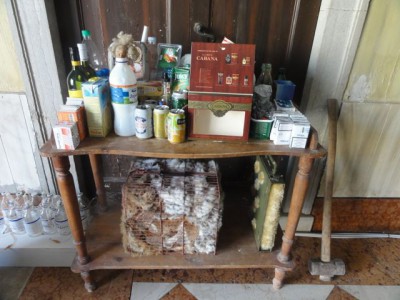 It was a pity that the installation of Jusuf Hadzifejzovic could not be shown in it. His was one of the important anniversary pieces of the exhibition and the artistic link to the presence of the Nine Dragon Heads in Sarajevo since the late 1990ties, since the first years after the war in Bosnia-Herzegovina. With its empty bottles and packaging’s of all sorts, the rusty grid with some dirty fur in it, Hadzifejzovic’s assemblage showed in an impressive and intentionally repellent way the misery of life in a town, in a country at war.
It was a pity that the installation of Jusuf Hadzifejzovic could not be shown in it. His was one of the important anniversary pieces of the exhibition and the artistic link to the presence of the Nine Dragon Heads in Sarajevo since the late 1990ties, since the first years after the war in Bosnia-Herzegovina. With its empty bottles and packaging’s of all sorts, the rusty grid with some dirty fur in it, Hadzifejzovic’s assemblage showed in an impressive and intentionally repellent way the misery of life in a town, in a country at war.
Painting in and with nature – Lim, Hyun Lak / Suh, Yoon Hee
The tent of Alois Schild was connected with Venice trough its specific connection with the 2015 Nine Dragon Head Biennale event, Hadzifejzovic’s through its contribution to the anniversary chapter. The two following projects are linked to Venice as they were entirely or partly realised on the island of Pellestrina, but in direct connection with the personal artistic languages of the Korean artists Lim, Hyun Lak and Suh, Yoon Hee, both special guests of the Nine Dragon Head event.
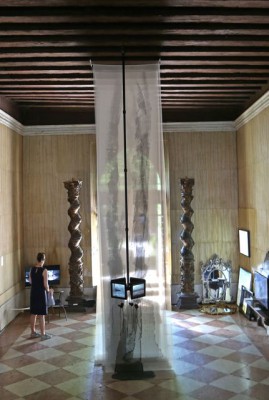 Lim and Suh’s work corresponds to the traditional image of Korean art: A strong relationship to nature, a strong wish for harmony and beauty and a spiritual dimension. Both however deal with it in a contemporary manner. In the reduction to the line as main movement, we find a direct reference of Lim, Hyun Lak to the internationally well known Korean artist Lee Ufan, but with the drawing of the lines – he calls them traces of breath – as performances and the free installation of the long textile drapes in the room, the artist finds his own way of reduction and correlation with nature, within a Buddhist universe. In the Palazzo he showed a series of semi-transparent fabric hanging from the ceiling, combined with a star like arrangement of four screens at eye-level, showing four drawing performances. One of them took place a few days previous on the long and impressive wave-break on the outskirts of the island of Pellestrina. The fabric was laid out on the top of the wall and the artist draw a black line with his huge brush in one continuous stream. Breath as a manifestation of time, movement and life could be felt. Three collaborators (here Enrique Munoz, Phil Dadson and Diek Grobler) followed the act of drawing with their cameras. The final video of the three views became part of the installation.
Lim and Suh’s work corresponds to the traditional image of Korean art: A strong relationship to nature, a strong wish for harmony and beauty and a spiritual dimension. Both however deal with it in a contemporary manner. In the reduction to the line as main movement, we find a direct reference of Lim, Hyun Lak to the internationally well known Korean artist Lee Ufan, but with the drawing of the lines – he calls them traces of breath – as performances and the free installation of the long textile drapes in the room, the artist finds his own way of reduction and correlation with nature, within a Buddhist universe. In the Palazzo he showed a series of semi-transparent fabric hanging from the ceiling, combined with a star like arrangement of four screens at eye-level, showing four drawing performances. One of them took place a few days previous on the long and impressive wave-break on the outskirts of the island of Pellestrina. The fabric was laid out on the top of the wall and the artist draw a black line with his huge brush in one continuous stream. Breath as a manifestation of time, movement and life could be felt. Three collaborators (here Enrique Munoz, Phil Dadson and Diek Grobler) followed the act of drawing with their cameras. The final video of the three views became part of the installation.
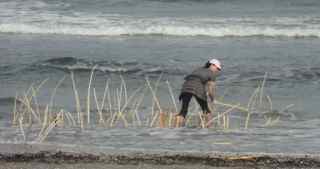 Suh, Yoon Hee works directly with natural material, not – or not only – for its own sake, but also as instruments to create her art. This method is also known in western art history, coming up in the 1970ties (for instance in the works of Herman de Vries – representing the Netherlands at the 56th Biennale – Mario Reis, Beatrix Sitter etc.). In Korea the relationship between art and nature is often virtual, it’s often the projection of a vision. Here it is far more real and that is the special quality of Suh, Yoon Hee’s art. Interesting is as well the combination with painting, her attempt to show that painting can be nature and nature can be painting. In an earlier exhibition in Seoul for instance, she laid out nature materials and at several points she installed water kettles that produced steam. The branches, stalks, plants began to secrete liquid onto the paper laid out beneath. Together with pigment powder, a “painting” was generated.
Suh, Yoon Hee works directly with natural material, not – or not only – for its own sake, but also as instruments to create her art. This method is also known in western art history, coming up in the 1970ties (for instance in the works of Herman de Vries – representing the Netherlands at the 56th Biennale – Mario Reis, Beatrix Sitter etc.). In Korea the relationship between art and nature is often virtual, it’s often the projection of a vision. Here it is far more real and that is the special quality of Suh, Yoon Hee’s art. Interesting is as well the combination with painting, her attempt to show that painting can be nature and nature can be painting. In an earlier exhibition in Seoul for instance, she laid out nature materials and at several points she installed water kettles that produced steam. The branches, stalks, plants began to secrete liquid onto the paper laid out beneath. Together with pigment powder, a “painting” was generated.
On the beach of Pellestrina, Suh made some sort of a three-dimensional “drawing” with slightly twisted, thin and peeled branches of different size, that she planted in the mud between water and sand. The waves gave the impression of an installation being on the move, forward and backwards without end. “Memory Gap” she called her project. As the installation was also a performance, documented by a Korean friend, the manifestation of her doing as being art was highlighted. Similarly in the second part of her work, in which she laid out bunches of plants right on the boarder between water and land, dispersed them with pigments and then filmed the short time during which the spreading out of the colours created a moment of self-generating painting. In the exhibition she showed an installation with the material used and the documenting video.
118 islands – Yoo, Joung Hye
 A more poetic than real link to Venice was behind the installation with the title “Garden of Coexistence”, that Yoo, Joung Hye realised for the Palazzo. This Korean artist has a special gift for transforming ordinary things into poetic objects. In the 9dh-Symposium in Biel/Bienne (2011) for instance, where all participants had bicycles for their mobility in town, she made little yellow flowers of creped paper which she fixed secretly onto each bicycle and thereby gave in this way a poetic brand to the group. For Venice she chose the number 118 – as there are 118 islands in the Venice lagoon. For each she crocheted with a fine copper wire a goblet-like form of a height of about 15 cm – red at the bottom shifting to white at the upward opening. In combination with mirror plates laid out on the ground (horizontal) and fixed on the wall (vertically) the goblets turned into a dense flower-“landscape” where the real and its reflection could hardly be distinguished any more. The fairly dark hall of the Palazzo was not an ideal place to give breath to the ground-installation of Yoo, Young Hye; it was as if the “music” of the poem wasn’t able to spread out sufficiently.
A more poetic than real link to Venice was behind the installation with the title “Garden of Coexistence”, that Yoo, Joung Hye realised for the Palazzo. This Korean artist has a special gift for transforming ordinary things into poetic objects. In the 9dh-Symposium in Biel/Bienne (2011) for instance, where all participants had bicycles for their mobility in town, she made little yellow flowers of creped paper which she fixed secretly onto each bicycle and thereby gave in this way a poetic brand to the group. For Venice she chose the number 118 – as there are 118 islands in the Venice lagoon. For each she crocheted with a fine copper wire a goblet-like form of a height of about 15 cm – red at the bottom shifting to white at the upward opening. In combination with mirror plates laid out on the ground (horizontal) and fixed on the wall (vertically) the goblets turned into a dense flower-“landscape” where the real and its reflection could hardly be distinguished any more. The fairly dark hall of the Palazzo was not an ideal place to give breath to the ground-installation of Yoo, Young Hye; it was as if the “music” of the poem wasn’t able to spread out sufficiently.
To travel makes us happy – Aleksandra Janik&Magdalena Hlawacz
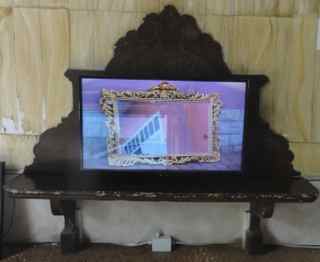 Mirrors were also a central element in the installation “Place. The Quest for the Quest” of the two Polish artists Aleksandra Janik&Magdalena Hlawacz. Their project can be called an homage to the “nomadic” vision of the Nine Dragon Heads. “The Quest for the Quest” expresses a poetic desire to be on the move, to find the own place, but without defining this place. “Place is everywhere”, they say.
Mirrors were also a central element in the installation “Place. The Quest for the Quest” of the two Polish artists Aleksandra Janik&Magdalena Hlawacz. Their project can be called an homage to the “nomadic” vision of the Nine Dragon Heads. “The Quest for the Quest” expresses a poetic desire to be on the move, to find the own place, but without defining this place. “Place is everywhere”, they say.
The installation combined baroque mirrors, typical of any Palazzo in Venice, with videos and photographs. Reflections, static views, photographs in photographs, moving images and more constructed an ensemble in a corner of the exhibition hall; on the ground, the wall and a bench of the Palazzo. It couldn’t really be grasped, as reality and mirroring were in constant interaction. The images, that could be seen, came partly out of Nomadic Parties with the Nine Dragon Heads (the drive through the dried out basin of the Aral Sea for instance), but showed also non-personal architecture, anonymous gardens, landscapes by night and more. The atmosphere on the whole was not menacing, nor critical in any context, but widely open, mostly bright and often with a blue sky over the horizon. The artists doubled this impression, saying that travelling makes them happy. Could it be that travelling is for them, having grown up in a communist country, is still something exceptional, that has to be pointed out as a great gift of life? Whereas for many others the possibility of travelling is taken for granted, just filled with the fear, that this might change in the future in view of the actual wars and tensions in the world?
Et in Arcadia ego – Chana Boon
Using photographs or videos of earlier journeys with the Nine Dragon Heads in new contexts, as to be seen in the project of Janik & Hlawacz, shows in a good way how the Nine Dragon Head activities spread out into the art world. The same could also be found in the film of Chana Boon “Et in Arcadia Ego”. Video sequences of the old rusty ships at the original bank of the Aral Sea (Nomadic Party 2012) appear along with footage of the 2012 elections in Georgia (which took place while the Nine Dragon Heads installed their exhibition at the Artisterium in Tibilisi). Both episodes are completely taken from the context of the Nomadic Party; to know this background is an extra for insiders, nothing else.
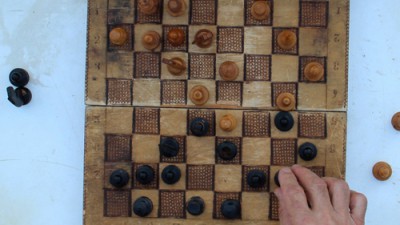 An earlier version of the film had already been shown in the Nine Dragon Head Exhibition “Preservation is Future” in the museum in Gwanju (KR) in 2013, but the artist continued to work on it and the final version, now shown in Venice, was fare more impressive, as the structure, the puzzle of the different image- and action-streams, was now comprehensible and convincing.
An earlier version of the film had already been shown in the Nine Dragon Head Exhibition “Preservation is Future” in the museum in Gwanju (KR) in 2013, but the artist continued to work on it and the final version, now shown in Venice, was fare more impressive, as the structure, the puzzle of the different image- and action-streams, was now comprehensible and convincing.
The topic of the film (30’) deals with the heritage of the policy of Stalin in the countries situated between Russia and Western Europe, above all the Ukraine.
The film is however not a political documentary, it is an artistic video, what means, among other criteria, that symbolic levels have a great importance. Here for instance the two old men, playing chess near a beach in Odessa called Arcadia. As the chess is almost a national game in Russia, in the film it becomes a complex metaphor of Stalins power plays. And also “Arcadia” doubles its meaning, as Boon starts with the famous 17th century painting of Poussin (based on a sentence of the latin author Virgil). In this painting, that is in an open form re-enacted for the film, shepherds discover a tomb with the inscription “Et in Arcadia ego” which is traditionally interpreted as the presence of death even in an ideal world, just as Stalin tried to sell it as a vision for communism. Death as it can be seen for instance in the drying out of the Aral Sea, due to the abuse of the water resources for the cotton production in the Ukraine.
The film had a special status within the “Jump into the Unknown”. On the one hand it did not really fit within the main theme of the exhibition but on the other hand it was the result of a Nine Dragon Heads work of several years in the making and had a corresponding quality. The artist was conscious about this problem, but unfortunately as she didn’t find the money to realise her original Venice project, which would have been the portrait of the last person responsible for the clock in the Venice clock tower on Saint Marcus’ Square, she decided to show “Et in Arcadia Ego”.
The view of the Guests
As already mentioned in this text, the Nine Dragon Heads projects and the works of the “Special Guests” from Korea supplemented each other, but cannot be commented on here in the same way because only few of the guests “jumped in the unknown” and because unfortunately only few of them spoke English so that a substantial dialogue was not possible.
Sim, Jean Bun
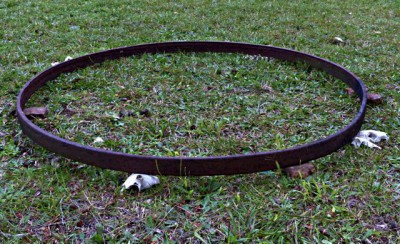 A special mention is however due to Sim, Jean Bun, who is well known to the Nine Dragon Heads, as she was travelling with 9dh through Usbekistan. In her work she combines geometric (man made) forms, above all the circle, with artefacts of nature, be it a stone, the skeleton of a dead animal or similar. The fragments she put under the iron circle (Ø 220 cm) in the garden of the palazzo were found pieces from the Nine Dragon Head Workshop on the three islands.
A special mention is however due to Sim, Jean Bun, who is well known to the Nine Dragon Heads, as she was travelling with 9dh through Usbekistan. In her work she combines geometric (man made) forms, above all the circle, with artefacts of nature, be it a stone, the skeleton of a dead animal or similar. The fragments she put under the iron circle (Ø 220 cm) in the garden of the palazzo were found pieces from the Nine Dragon Head Workshop on the three islands.
Goo, Sung Kyun
 also tried to create with reference to Venice, but he might have misunderstood the “water problem” of the city, which is not a fresh, but largely a salt-water problem. His project dealt however with fresh water as being the “heart” of the unity of man and nature. Goo, who calls himself an environmental artist, expressed in his installation of eight transparent rain coats with fine tubes on the inside, concentrated especially in the heart area. A pump system made the water in them slowly circulate and the red pigment made this visible. Water as source of life is a common topic in Korean art; personally I remember well the performance of Nine Dragon Head Pang, Hyo Sung during the Sarajevo Winter Festival 2014, in which he showed the existential dimension of water and our duty to be constantly aware of its preciousness.
also tried to create with reference to Venice, but he might have misunderstood the “water problem” of the city, which is not a fresh, but largely a salt-water problem. His project dealt however with fresh water as being the “heart” of the unity of man and nature. Goo, who calls himself an environmental artist, expressed in his installation of eight transparent rain coats with fine tubes on the inside, concentrated especially in the heart area. A pump system made the water in them slowly circulate and the red pigment made this visible. Water as source of life is a common topic in Korean art; personally I remember well the performance of Nine Dragon Head Pang, Hyo Sung during the Sarajevo Winter Festival 2014, in which he showed the existential dimension of water and our duty to be constantly aware of its preciousness.
Choi, Ik Gyu
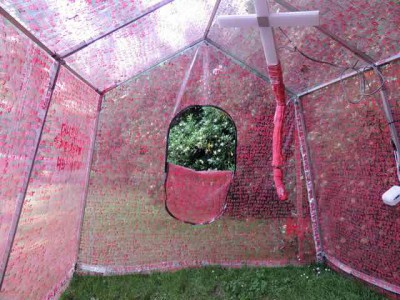 brought a very personal work to Venice. “Travel” had however a touching relationship to the theme of the exhibition, the Jump into the Unknown. In a short essay he describes his feeling of being a human in this absurd world; something that is rare in Korea, where the focus is very much turned inwards. Choi however says that even for him, being a little monster, there is no other possibility but to jump for moments of happiness. In Venice he showed his vision in form of a transparent plastic tent with the mentioned essay written on the surface; in red ink. Inside hung a white blinking cross with a red textile appendage, suggesting a flesh-like (human) material. I would have liked to close the tent, have a little seat to sit down on and get calm and reflect; not just intellectually, above all bodily. The busy atmosphere of the very diverse group show did however not give me this reflective space.
brought a very personal work to Venice. “Travel” had however a touching relationship to the theme of the exhibition, the Jump into the Unknown. In a short essay he describes his feeling of being a human in this absurd world; something that is rare in Korea, where the focus is very much turned inwards. Choi however says that even for him, being a little monster, there is no other possibility but to jump for moments of happiness. In Venice he showed his vision in form of a transparent plastic tent with the mentioned essay written on the surface; in red ink. Inside hung a white blinking cross with a red textile appendage, suggesting a flesh-like (human) material. I would have liked to close the tent, have a little seat to sit down on and get calm and reflect; not just intellectually, above all bodily. The busy atmosphere of the very diverse group show did however not give me this reflective space.
Kim, Dong Young and Seo, Bak Ei and Song, Dae Sup brought works from their ateliers to the show.
Kim, Dong Young
describes his working as a dialogue with God. The way this appears artistically is a work in mixed media technique on black and white paper with fabric, laces, scripture and painted forms. The Venice piece became, in the context of the fairly dark Palazzo hall, a sort of a silent wall altar.
Song, Dae Sup
Much more vivid were the two paintings of Song, Dae Sup. With the title “Mud Flat” he refers to a zone where water and land are not clearly separated, what inspired him to interpret it as a zone of upcoming life. Thousands of colourful, slightly irregular, thin ribbons build a loose texture all over the Korean paper used. It’s as if it were how it would be to be in a constant flow made by subterranean waves. It is interesting, that not less than three Korean artists were inspired by liminal space between sea and land: Yoo, La Shin, Suh, Yoon Hee and Song, Dae Sup.
Seo, Bak Ei
The work of Seo, Bak Ei – philosophically not very far from Song, Dae Sup – deals with life in a constant shift between “Dissolution & Cohesion”. The mosaic like technique with wooden stamps in different blue tonalities showed nature as a magnetic field, constructing and deconstructing itself endlessly.
Conclusion:
Jump to the Unknown was a very rich exhibition including historical references of the Nine Dragon Head’s past, but above all many interesting artistic positions in the presence. To grasp the full dimension of the 32 installations, videos, objects, paintings and also the performances in addition, was however a task, that – I dare presume – nobody could, nobody wanted to fulfil. The catalogue that was edited for the exhibition gave important references for the understanding of the cultural, philosophical, historical background of the works, mostly in the words of the artists themselves. The information plates next to each work also tried to give information to the audience. Both were very important and a great work.
The second catalogue is going to be a documentation of the setting of the exhibition itself.
So the challenge of this text for the catalogue of the on-going activities of the Nine Dragon Heads was to interpret the works from an outside perspective, trying to give them their position within the exhibition and within the whole project of Nine Dragon Heads event at the 56th Biennale in Venice.
The Palazzo Loredan was a charming surrounding for the presentation of the works, but it was of course not a museum with all its facilities and it was not possible to give sufficient room to all the projects. Quite a few could not really reveal their potential, as they were and are universes in themselves.
The Jump into the Unknown was a chance to show the importance of the Nine Dragon Heads artists in relation to their oeuvre as a whole. Something that is not possible nor intended during the Symposia and Nomadic Parties. That is why I personally regretted, that there was no official platform for the artists to exchange their visions, to discuss the works beyond the surface of their appearance in Venice. This would have enabled an exploration of the dimensions of the individual positions in the artist’s home countries as well as in an international art context.
The crucial question, that is expected here, is the question: Was the very, very expensive Venice event a good investment? From the point of view of the artists, from the point of view of the reputation of Nine Dragon Head as an international brand in the art world? I can’t say “yes” or “no” – as there are arguments on both sides in one as well as in the other direction, but I am almost sure that the weight of the positive dominates.
One statement I can make with conviction is however: An event like “Jump into the Unknown” can never replace the Symposia and Nomadic Parties with their extraordinary atmosphere of experiencing an inspiring time of artistic creation together in the group that is Nine Dragon Heads.
The text mentions all participant artists and all projects except from some performances given during special events.
The photographs are made either by Enrique Muñoz Garcìa or azw.
As English is not the mother tongue of the author, the editing was laborious. A great Thank-You is due to Suzanne Bartos for her excellent work.



